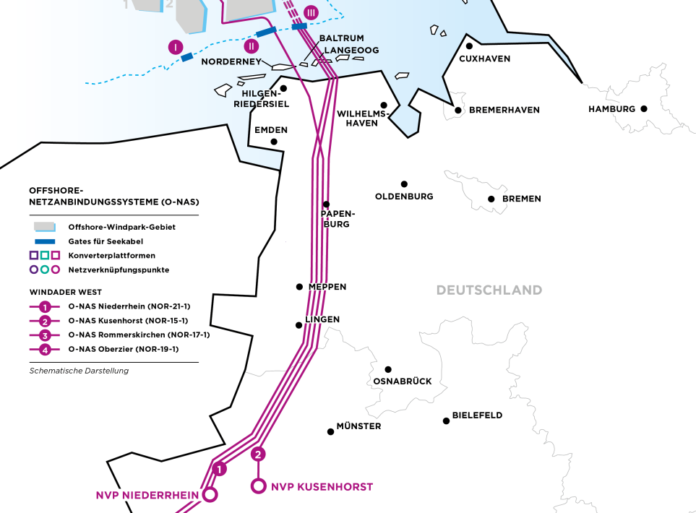Germany-based transmission operator Amprion Offshore GmbH has begun planning the Windader West energy corridor. The connection should bring up to 8 GW of offshore wind energy directly to the North Rhine-Westphalia region and cover the energy needs of 8 million people in the industrial stronghold.
In order for Germany to achieve its climate goals, offshore wind farms should provide as much output in 2035 as around 50 large coal-fired power plants. Offshore wind energy is to replace conventional energy sources, especially in the load centers in western Germany. This not only requires new offshore wind farms, but also new lines that connect them to the transmission grid on land – so-called offshore grid connection systems.
The Windader West energy corridor includes four offshore grid connection systems: NOR-15-1, 17-1, 19-1 and 21-1 which will feed North Sea wind power into the transmission grid. The submarine cables will begin at the wind farms in the North Sea and are bundled as underground cables from the coast to their grid connection points in the Rhine-Ruhr metropolitan region.
The grid connection systems will be installed parallel to each other on the land side and, for the most part, also on the sea side. Onshore, the projects are planned as underground cables using direct current technology. In 2032, the first 2 GW of offshore capacity are to flow to North Rhine-Westphalia via a line from Windader West. The remaining three lines are scheduled to go into operation in 2033, 2034 and 2036.
“The Windader West combines four projects with a transmission capacity of 2,000 MW each. The systems belong to the new powerful 2 GW generation of offshore connections,” says Peter Barth, managing director of Amprion Offshore GmbH. “Amprion is thus making a significant contribution to the efficient and rapid conversion of the energy system in order to bring large quantities of wind energy to North Rhine-Westphalia.”
A route corridor for the route of the underground cables is in the early stage of development. In October, Amprion will hold informational meetings about the project with the public and local stakeholders to collect data that will be crucial for regional planning, which is the first step in obtaining approval for the venture.
A converter station is required near the respective grid connection point, which converts the incoming direct current into alternating current and feeds it into the power grid on land. Prospective areas for the converter sites around the grid connection points are currently being determined. Amprion wants to make the search for a location transparent and has already contacted the neighboring municipalities.




